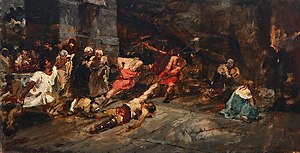Spoliarium
[3] Filipino historian Ambeth Ocampo writes, "...the fact remains that when Luna and Félix Resurrección Hidalgo won the top awards in the Madrid Exposition of 1884, they proved to the world that indios could, despite their supposed barbarian race, paint better than the Spaniards who colonized them.
"[4] At a gathering of Filipino expatriates in Madrid, José Rizal enthusiastically toasted the triumphs his two compatriots had achieved, the other being Félix Hidalgo who won a silver medal, calling it "fresh proof of racial equality".
[5] "Luna's Spoliarium with its bloody carcasses of slave gladiators being dragged away from the arena where they had entertained their Roman oppressors with their lives... stripped to satisfy the lewd contempt of their Roman persecutors with their honor...."[6] Rizal was footnoted in his speech that the Spoliarium, "embodied the essence of our social, moral and political life: humanity in severe ordeal, humanity unredeemed, reason and idealism in open struggle with prejudice, fanaticism and injustice.
"[6] Rizal was inspired to carve a mark of his own to give glory to his country by writing his 'Spoliarium' since early that year 1884 "he had been toying with the idea of a book" for he has seen and described the painting as "the tumult of the crowd, the shouts of slaves, the metallic clatter of dead men's armor, the sobs of orphans, the murmured prayers..." Rizal's book would be called Noli Me Tangere, "the Latin echo of the Spoliarium".
Artist Antonio Dumlao[3] was chosen by Carlos da Silva, as head of the Juan Luna Centennial Commission,[9] to perform relining and cleaning of the painting.
Based on the literature, the study featured a peculiar signature written by Luna in baybayin script on the canvas's lower right side.
[13][14] The painting later ended in the ownership of Don Jose Vazquez Castiñeira, a former mayor of Sarria, a municipality in the province of Lugo in Spain for nearly 130 years.
[12] In 1996, Maria Nuñez Rodriguez, a childless widow of Don Francisco Vazquez Gayoso summoned her relatives into her household able to divide her estate.

